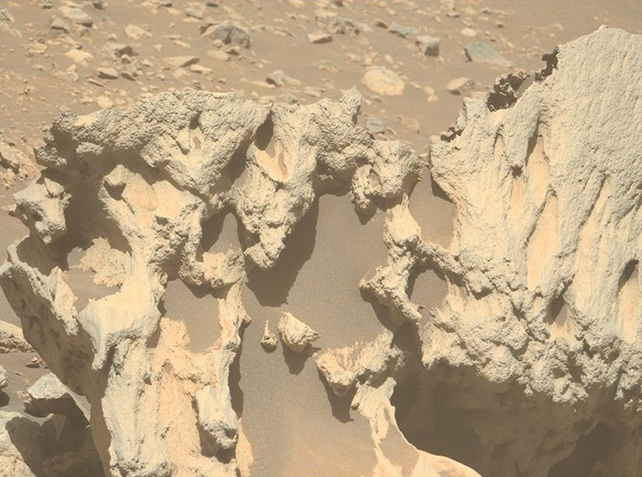More than five years into its mission, NASA's Mars Perseverance rover is still ambling across the surface of the red planet, doing what any five-year-old loves to do – stopping to look at every rock on its path.
One of its latest discoveries happens to look surprisingly out of place, prompting scientists to wonder if it may not have come from Mars at all.
Found in the Vernodden area of Jezero Crater, the 80-centimeter- (about 31-inch-) wide rock was given the name Phippsaksla. We now have two photos of the rock from NASA, showing it up close and from a little farther away.
What makes Phippsaksla something of a stranger in its geological neighborhood is its composition: being rich in iron and nickel suggests that it hasn't always lived on Mars, and is in fact a meteorite that crashed into the planet at some point in the past.
Related: Tiny 'Coral' Discovered by Rover in Martian Crater
Far less common than their stony cousins, iron-nickel meteorites are typically formed from the core of large asteroids, created as heavy minerals sank into the hearts of heated rocks in the early days of the Solar System.
NASA scientists first noticed the rock for its unique shape. It looks larger and stands higher than others in its surroundings, with a curiously sculpted appearance. With an attractive new target in its sights, Perseverance snapped a couple of pictures using one of the advanced Mastcam-Z cameras fixed to its mast.

The rover used its SuperCam instrument's lasers and spectrometers (measuring light wavelengths) to analyze Phippsaksla's chemistry, providing a clear measure of its iron and nickel content.
While Phippsaksla may be a distant visitor from outer space, its presence in the Vernodden area of Jezero Crater may not be entirely unexpected. Iron-nickel meteorites have been found in other places on Mars already, making it something of a surprise that Perseverance hadn't come across one before now.
Further analysis is going to be required to confirm that this is indeed a meteorite sitting on the surface of Mars, but if it is, it's another significant first for Perseverance – and one that gives us more clues about the red planet and its history.
Using an onboard drill, Perseverance is the first rover to collect Martian rock samples. A miniature lab built into the rover then allows researchers to take a closer look at these samples and identify their origins.
Should NASA decide it's worth bringing a piece of Phippsaksla back home, samples can be stowed away for future transport. Unfortunately, Perseverance can't ship any of its rock collection back to Earth unassisted: we'll need another craft to go and get the samples.
Perseverance has achieved a lot since it landed on Mars in February 2021. It's traveled around ancient lake beds, discovered fascinating rocks on the surface, and found signs that life may have once existed on the planet.
The rover has been able to give us a close-up look at some of the features of the Martian landscape – including volcanoes – that isn't possible with telescopes here on Earth, as advanced as they now are.
Perseverance has even set a new record for road trips on another planet, and there's likely to be much more to come from the intrepid explorer. There's no set date for the end of its mission, meaning this plucky little rock enthusiast may continue to find new stones to share for a while longer yet.

